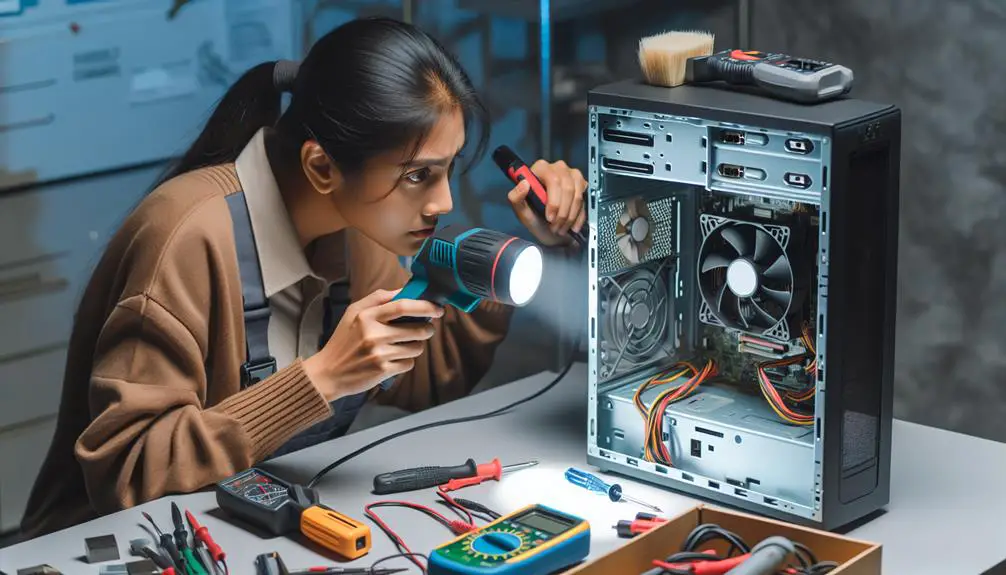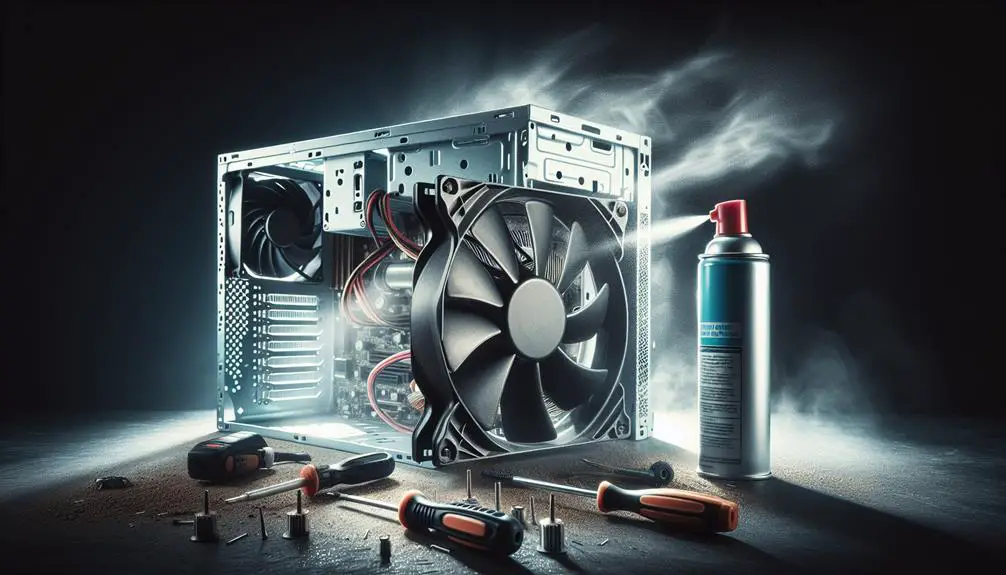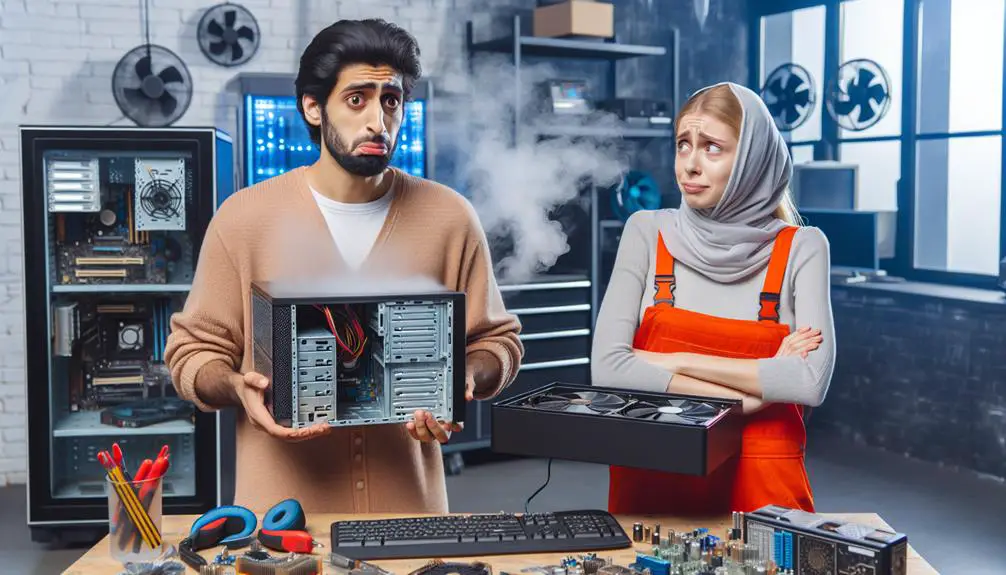To fix a non-working cooling fan, start with identifying the issue.
Inspect the fan blades and test the motor.
Consider professional help if needed.
Identify the Problem

When your cooling fan stops working, it's critical to initially identify the underlying issue causing the malfunction. Start by observing if there's any sound coming from the fan when you attempt to turn it on. A humming noise could indicate a problem with the motor, whereas complete silence might suggest a different issue.
Next, check for any visible signs of damage or blockage. Dust and debris can accumulate over time, obstructing the fan's blades and preventing them from spinning. Carefully cleaning the blades and surrounding area can sometimes resolve the issue. If you notice any physical damage to the blades or the motor itself, this could be the root cause of the malfunction.
It's also wise to take into account the age of your cooling fan. Over time, wear and tear can degrade its components, leading to inefficiencies or complete failure. If your fan is particularly old, the problem might simply be because its lifespan reaching its end.
Check Power Supply
Before proceeding with more complex troubleshooting techniques, it's vital to check the cooling fan's power supply to make sure it's properly connected and receiving power. This step is critical as even the most advanced diagnostics won't help if your fan isn't powered. Here's a straightforward list to guide you through this process:
- Make sure the Fan's Power Cord is Plugged In: It sounds simple, but it's often overlooked. Verify the fan's plug is securely inserted into a working electrical outlet. If it's loose, push it in firmly.
- Test the Outlet: Sometimes, the issue isn't with the fan but with the power source. Plug another device into the same outlet to see if it works. If the device doesn't power on, the problem might be with your electrical outlet.
- Check the Fuse or Circuit Breaker: A blown fuse or tripped circuit breaker can cut power to your fan. Check your home's fuse box or circuit breaker and make the necessary adjustments.
- Inspect the Power Cord for Damage: Look over the fan's power cord for any signs of wear, tear, or damage. A frayed or damaged cord can interrupt the power supply to your fan and may need replacing.
Inspect Fan Blades

After ensuring your fan's power supply is in check, it's time to examine the fan blades for any obstructions or damage.
First off, make sure the fan is off and unplugged. Safety foremost! Now, take a close look at the blades. Are they dusty or dirty? Dust can greatly reduce a fan's efficiency and even cause it to stop working altogether. If they're dirty, give them a gentle but thorough cleaning. Use a soft, slightly damp cloth to wipe down the blades. Avoid using water directly, as moisture can damage the fan's motor.
Next, check for any signs of physical damage. Are the blades warped, cracked, or broken? Even a small crack can throw off the balance, leading to further issues down the line. If you find any damage, you might need to replace the blades to get your fan working again.
Lastly, make sure the blades are securely attached. A loose blade can cause vibrations and noise, and in some cases, prevent the fan from spinning altogether. Tighten any screws if necessary but be careful not to over-tighten, as this could cause damage.
Test the Motor
If your fan's blades are in good condition, the next step is to test the motor to make sure it's functioning properly. The motor is the heart of your fan, and if it's not working, your fan won't be able to circulate air.
Here's a simple guide to help you test the motor effectively:
- Unplug Your Fan: Safety primary! Always make sure your fan is unplugged before attempting any diagnostics or repairs.
- Access the Motor: Depending on your fan model, you might need to remove a few screws or panels to get to the motor. Take note of how everything fits together so you can reassemble it easily.
- Check for Obstructions: Sometimes, debris can get into the motor housing and prevent it from spinning. Clear any dust, hair, or other obstructions you find.
- Test the Continuity: Using a multimeter, check the continuity of the motor. If there's no continuity, it means there's a break somewhere in the circuit, and the motor might need replacing.
Seek Professional Help

When all attempts to diagnose and fix the motor prove fruitless, it's time to seek professional help. Don't feel defeated; it's smart to recognize when an issue is beyond your expertise. A qualified technician can offer you peace of mind and a proper diagnosis. They've got the tools, skills, and experience to pinpoint the exact problem, whether it's a faulty motor, electrical issues, or something else entirely.
Before you call in the pros, make sure you've got your fan's make, model, and any symptoms or troubleshooting steps you've taken on hand. This information can save time and potentially money by guiding the technician straight to the likely sources of trouble.
Finding the right help is essential. Look for a reputable service with good reviews and preferably one that specializes in your type of fan or its brand. Don't hesitate to ask for an estimate or if they guarantee their work. Remember, investing in professional repair can often be more cost-effective than a DIY fix gone wrong or the expense of a full replacement.
Conclusion
In summary, when your cooling fan stops working, start by identifying the problem. Make sure it's plugged in and check the power supply.
Next, inspect the fan blades for any obstructions or damage. If they're clear, test the motor to see if it's functioning properly.
If you're still facing issues, it's time to seek professional help. Tackling the problem step by step will save you time and possibly money, getting your cooling fan back up and running smoothly.